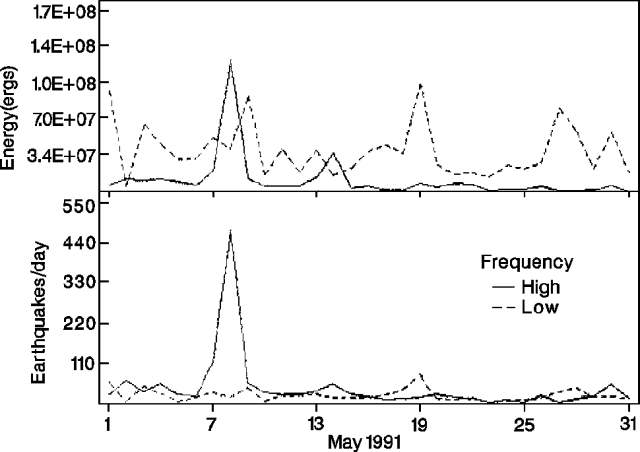Report on Nevado del Ruiz (Colombia) — May 1991
Bulletin of the Global Volcanism Network, vol. 16, no. 5 (May 1991)
Managing Editor: Lindsay McClelland.
Nevado del Ruiz (Colombia) Frequent lithic ash emissions; occasional vigorous earthquake swarms
Please cite this report as:
Global Volcanism Program, 1991. Report on Nevado del Ruiz (Colombia) (McClelland, L., ed.). Bulletin of the Global Volcanism Network, 16:5. Smithsonian Institution. https://doi.org/10.5479/si.GVP.BGVN199105-351020
Nevado del Ruiz
Colombia
4.892°N, 75.324°W; summit elev. 5279 m
All times are local (unless otherwise noted)
Lithic ash emissions were frequent during May, depositing material to Manizales (30 km WNW) on 1 May. Short pulses of shallow tremor were associated with the emissions. High-frequency seismicity reached very high levels during a swarm on 8 May (figure 45), which included a M 2.1 earthquake, 2.5 km N of Arenas crater at 5 km depth. A similar swarm occurred on 14 May. Low-frequency seismicity was at a moderate level in May, with peaks of vigorous seismicity on 4 days. Deformation measurements showed no significant changes. The SO2 flux was low; the monthly average was 930 t/d, compared to ~2,740 t/d in April.
 |
Figure 45. Daily number of seismic events (bottom) and energy release (top) at Ruiz, May 1991. Solid line, high-frequency events; dashed line, low-frequency events. Courtesy of INGEOMINAS. |
Geological Summary. Nevado del Ruiz is a broad, glacier-covered volcano in central Colombia that covers more than 200 km2. Three major edifices, composed of andesitic and dacitic lavas and andesitic pyroclastics, have been constructed since the beginning of the Pleistocene. The modern cone consists of a broad cluster of lava domes built within the caldera of an older edifice. The 1-km-wide, 240-m-deep Arenas crater occupies the summit. The prominent La Olleta pyroclastic cone located on the SW flank may also have been active in historical time. Steep headwalls of massive landslides cut the flanks. Melting of its summit icecap during historical eruptions, which date back to the 16th century, has resulted in devastating lahars, including one in 1985 that was South America's deadliest eruption.
Information Contacts: C. Carvajal, INGEOMINAS, Manizales.

